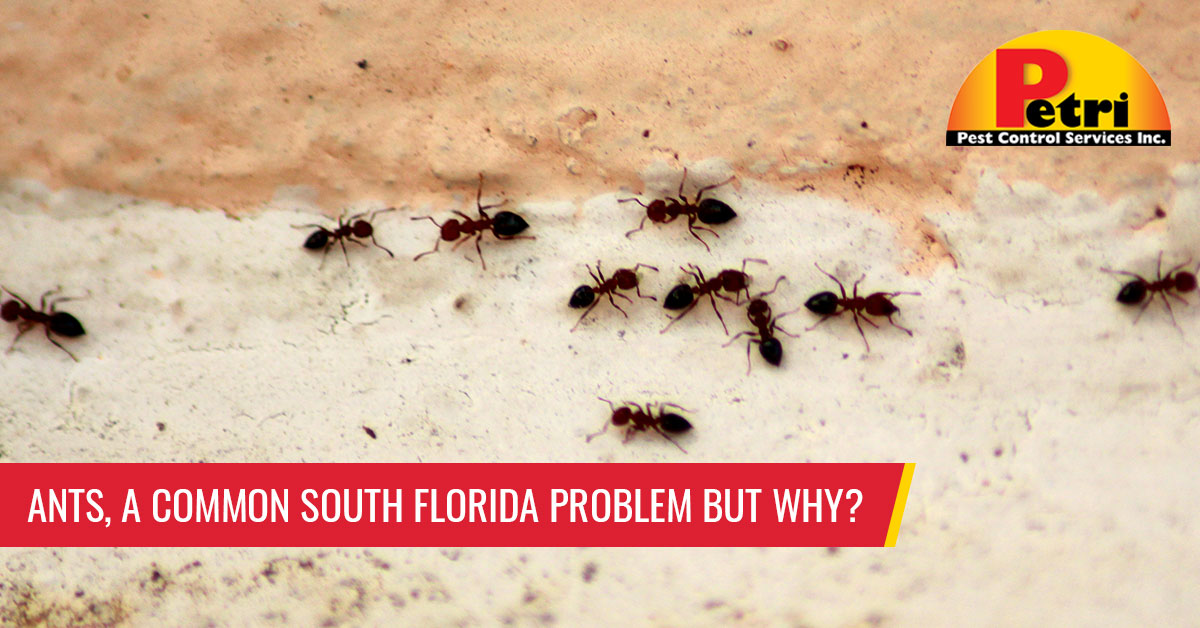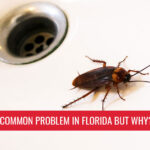
Ants are a common problem in South Florida homes. Let’s take a look at why and review the types of common ants typically found in South Florida homes and lawns, how to identify them, and what to do if ants are taking over your home. It’s not uncommon in South Florida to go from an ant-free home one day to an ant-filled home the next and it’s even rarer to reverse that process once ants find food and water sources in your home.
Of the many ants that South Florida hosts, the most common include:
- Ghost Ants – commonly referred to as “Sugar Ants”, they are small,?? at 1.5 mm, these tiny ants have dark heads and white or translucent bodies, making them difficult to see. Their erratic behavior enhances their otherworldly reputation, seeming to appear in one place one moment and another the next. They usually live in nests outside your home but are not opposed to moving into wall voids in kitchens, if the food and water sources are optimal. In search of sweets, sugar ants can infest dry goods bags and boxes by chewing through packaging with their sharp, little teeth, ruining your dry goods. Sugar ants are most likely attracted to the honeydew secreted by aphids and other plant insects on the exterior of your home. Entering homes can be easy when you’re as small as sugar ants. Sometimes sugar ants nest in wall voids or potted plants once inside homes.
- Pharaoh Ants – About 2 mm long, light yellow with red and black markings on their abdomens, these pests forage in strong, tightly linked trails, with multiple queens and multiple nesting locations. Pharaoh ants are difficult to eliminate. Adaptable, readily nesting in leaf debris outside, pharaoh ants will nest indoors in cabinets, wall voids, food boxes, crevices, and other spaces. Professional pest control services are usually required to eradicate pharaoh ants because they can survive most DIY pest products.
- Big-Headed Ants – An invasive species, 1.5 to 4.5 mm long, ranging from dark brown to shades of red to light yellow, big-headed ants get their name from the large heads of major workers in this species. Difficult to control, these soil-nesting pests build super-colonies, or a network of nests, with multiple queens that can reproduce year-round. Preferring a mixed diet of honeydew-producing insects and other small insects, big-headed ants can wreak havoc on your tropical landscape in South Florida. Big-headed ants excavate soil and are often mistaken for subterranean termites due to their habit of building tubes that trail trees or up the sides of buildings.
- White-Footed Ants – Medium-small at 2.5-3 mm long, black to brownish-black, with yellowish-white feet, these ants rank among the most common South Florida ant species. Although white-footed ants do not pose any health threats to humans, their large colonies allow for a frightening number of white-footed ants to trail on the exterior of buildings, invading homes through cracks and crevices into kitchens and baths in search of moisture and sweets. Nesting outside in bushes, mulch beds, leaf litter, and trees, white-footed ants can gain access to soffit vents and infest hard-to-reach voids.
- Red Fire Ants – Ranging from dark reddish-brown to black and measuring from 1/8-1/4 of an inch long, red fire ant bites feel like fire and are extremely painful. Fire ants can sting multiple times and coordinate with other members of their colonies to attack at the same time. Fire ant bites can be fatal depending on the number of times a victim is stung. The good news is that red fire ants generally avoid humans, building unsightly mounds to live in sunny wide-open areas. South Florida residents that coexist with fire ants should mark the areas where the mounds are in their yards to prevent someone from stumbling upon them by accident.
- Carpenter Ants – Also known as “Bull Ants,” measuring from 1/10-3/4 of an inch, Florida carpenter ants are bicolored appearing reddish-brown with a brown or black abdomen. Carpenter ant bites are particularly painful to humans and pets so take care when dealing with them. Carpenter ants tend to build their nests in pre-existing voids in walls or in damp and moisture-weakened wood they can burrow into. However, they cannot excavate sound wood. Carpenter ants can cause structural damage, like termites, but they don’t eat wood but rather carve it out to nest in. Carpenter ants often build satellite nests in yards and landscapes, making it difficult to eliminate them.
How Do You Keep Ants Out of Your Home?
Concerned homeowners can take several proactive steps to make their homes less attractive and accessible to ants including:
- Keep branches trimmed away from your home to avoid creating bridges that ants can travel on to enter.
- Seal all cracks and crevices in and around your foundation, entryways, and windows.
- Attach window-grade screening across dryer vents.
- Inspect weather-stripping for wear and gaps that ants can get through.
- Keep firewood stacked at least ten feet away from your house.
- Eliminate wood piles, rotten wood, and leaf debris from your yard.
- Check where your plumbing and utilities go through walls for gaps and seal them up if you find any.
How to Keep Ants Away From Your Home
Eliminating food and water opportunities on the exterior of your home can reduce the attractiveness of your home to pests. Some of the things you can do include:
- Store your trash in containers with tight-fitting lids to conceal it from ants and other pests.
- Keep your trash receptacle pad clean and sanitized; this will dissuade ants from seeking food around your trash receptacles.
- If you feed your pets outside, remove bowls between meals.
- Keep gutters clean and downspouts draining correctly.
- Repair leaky spigots and hoses.
- Space out landscape plants, so the ground can dry out.
- If you have honeydew-producing insects, such as aphids, whiteflies, or scale insects in your landscape, look into elimination methods.
- Make sure all your gutters are clear and working properly.
Ants can be annoying and problematic in South Florida, as they are not easy to eradicate. Most ants you encounter in your kitchen and bathrooms live in nests in your yard or hard-to-reach wall voids in your home. To eradicate ants, a professional pest control technician is usually required to strategically place baits near where nests are located. Contact Petri Pest Control Services for a free pest inspection and to customize a plan to keep pests from getting near your home with baiting systems placed where pest infestations are most likely to happen, at the perimeter of your property.
Ants, A Common South Florida Problem But Why in South Florida?
Serving Broward County and Palm Beach County


